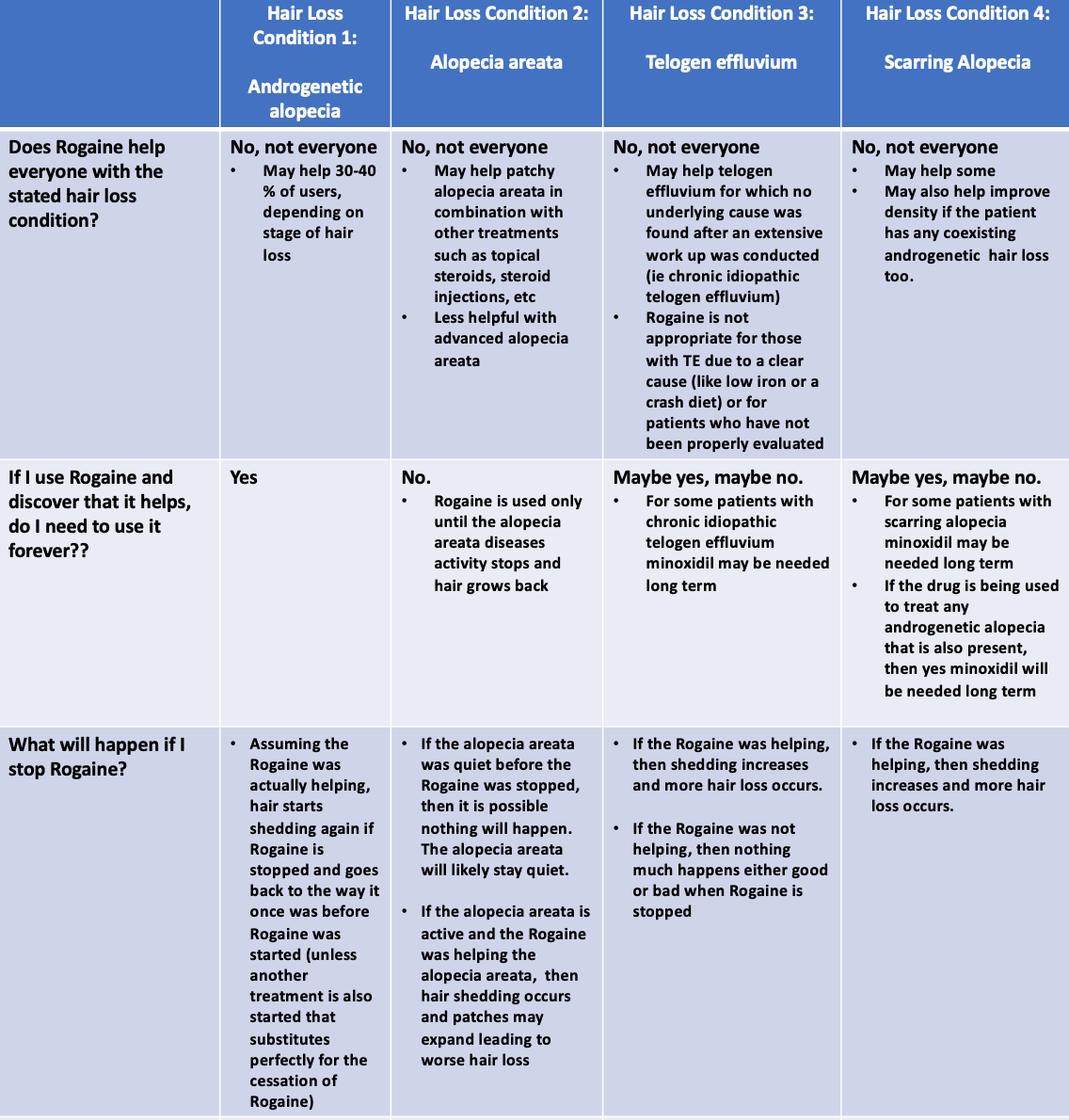Minoxidil and Rogaine: Do I really have to use them forever ?
The Use of Rogaine Is Always “Forever” in Androgenetic Alopecia But May not be for Other Forms of Hair Loss
I’m often asked by patients if they need to use their minoxidil (ie Rogaine or generic medications) forever.
When I hear this question, I usually reply with a question “what type of hair loss are you using the minoxidil for?”
Generally speaking, if the minoxidil is being used for androgenetic alopecia (male and female pattern hair loss), the rules are very simple: Minoxidil needs to be used forever and any attempt to stop will just lead to hair loss. Of course, if a person with androgenetic alopecia wishes to stop minoxidil (ie Rogaine) and substitute something else like antiandrogens, laser or PRP treatments, there is a possibility that the new treatment will substitute perfectly and the patient won’t lose hair. That’s assuming of course that the new planned treatment actually works !
If the patient is using topical minoxidil for another reason, like telogenn effluvium or scarring alopecia or alopecia areata, the rules are a bit different. It may or may not be possible to stop the minoxidil - but often there is a possibility of stopping.
Alopecia Areata:
Generally for patchy alopecia areata, Rogaine can be used in combination with topical steroids or steroid injections to help fill in the patches of hair loss. Then, the Rogaine can be stopped once the hair regrows fully. If the patient develops a patch of alopecia areata in the future sometime, topical Rogaine can be started again in combination with other treatments.
Telogen Effluvium:
Generally for most patients with telogen effluvium, Rogaine should just be kept in the drug store. I’m not a big fan of using Rogaine in a telogen effluvium. The reason is really simple: the goal of treatment for telogen effluvium is to treat the actual cause of the telogen effluvium not put a bandaid on it like Rogaine. If the patient in front of you has low ferritin levels (low iron) from a bleeding colon cancer, the goal is to get in there and find the cancer and get the patient connected with the right treatment. Assuring the patient that everything will be fine with the hair and that they just need to use Rogaine is not the way to go,
Now, there are some patients with chronic shedding who shed and shed with no clear reason. Their iron levels are fine. Their thyroid hormones are fine. They have not been on a diet. There are no new medications that were recently started. And they are shedding and shedding hair. So why are they shedding? Many of theses patients have what is called chronic idiopathic telogen effluvium. We don’t know the cause. In this case, topical minoxidil might help stop shedding or at least reduce it a bit. We don’t know if Rogaine will be needed long term in these situations or not. It very well may be.
Scarring Alopecia:
Topical minoxidil (Rogaine) is not really a very good starting point for treating scarring alopecia. The treatments for scarring alopecias typically involve starting with treatments that stop inflammation. There are 20 different types of scarring alopecias so I can’t go into all treatments in once paragraph. But the message is clear: The first line treatment is to get the inflammation out of the scalp.
Minoxidil may have a role to encourage hairs to push back up through the scalp once the inflammation is chased away. And so, not surprisingly, I may advise use of Rogaine (minoxidil etc) in my patients with scarring alopecia who are turning the corner with getting their scalp inflammation under control. I want to send a message to the injured hairs that did not die off “ you may have been injured by all the inflammation you have endured now you can push push back thorough the scalp surface and keep growing strong.” Rogaine can help with this.
What we don’t know with scarring alopecia its whether we’ll need to use minoxidil forever. We may need too. Some hairs will need Rogaine to keep growing. The hairs appear to need that signal to keep pushing through all the scar tissue.
(It reminds me of my friend’s 16 year old dog who needs to be shown a biscuit in order to walk down the street. No biscuit in hand by the owner means no movement of the dog. Some hairs in scarring alopecia are like that when it comes to Rogaine. No Rogaine means no growth).
Summary
The following table summarizes some of the growth considerations for the use of minoxidil (Rogaine) in various hair loss conditions.
This article was written by Dr. Jeff Donovan, a Canadian and US board certified dermatologist specializing exclusively in hair loss.

